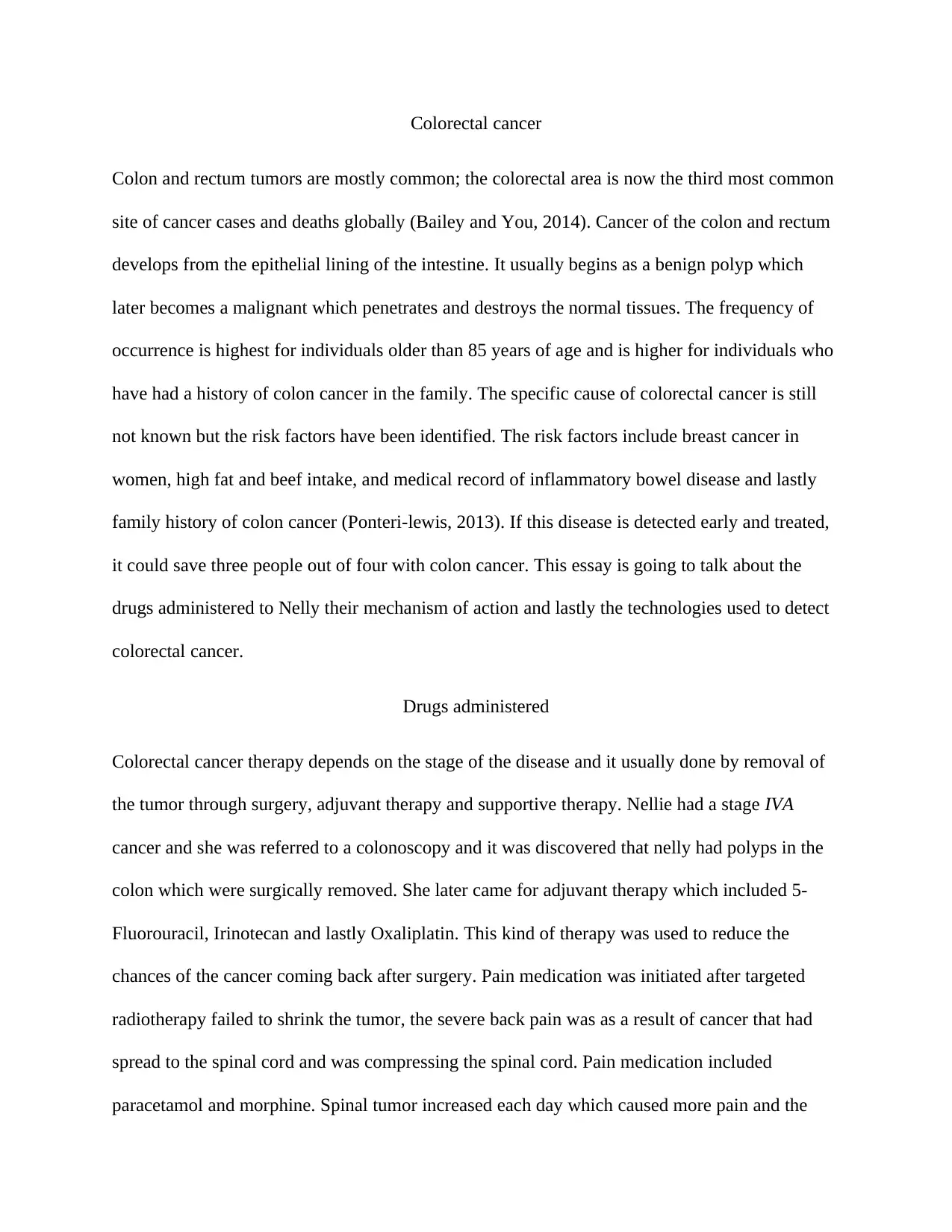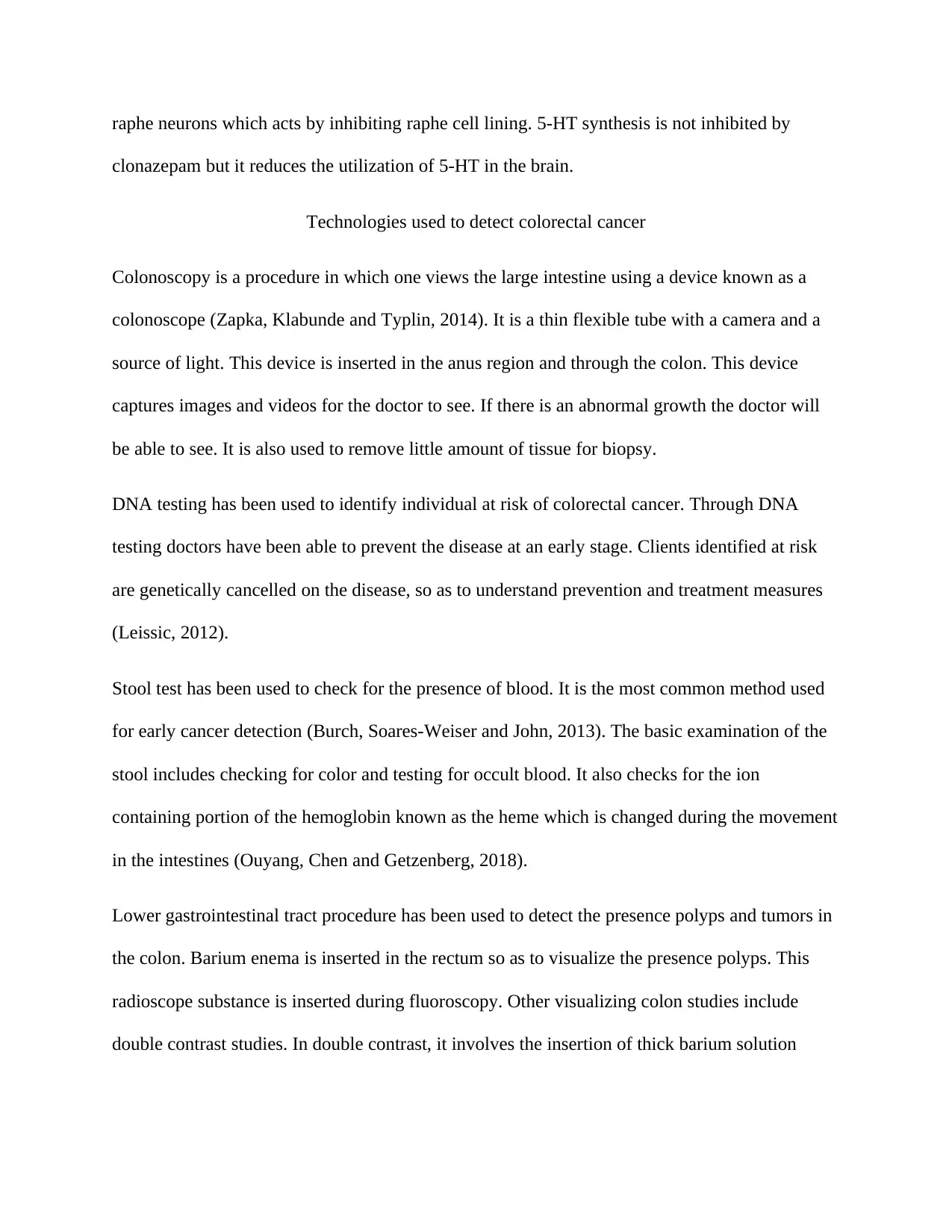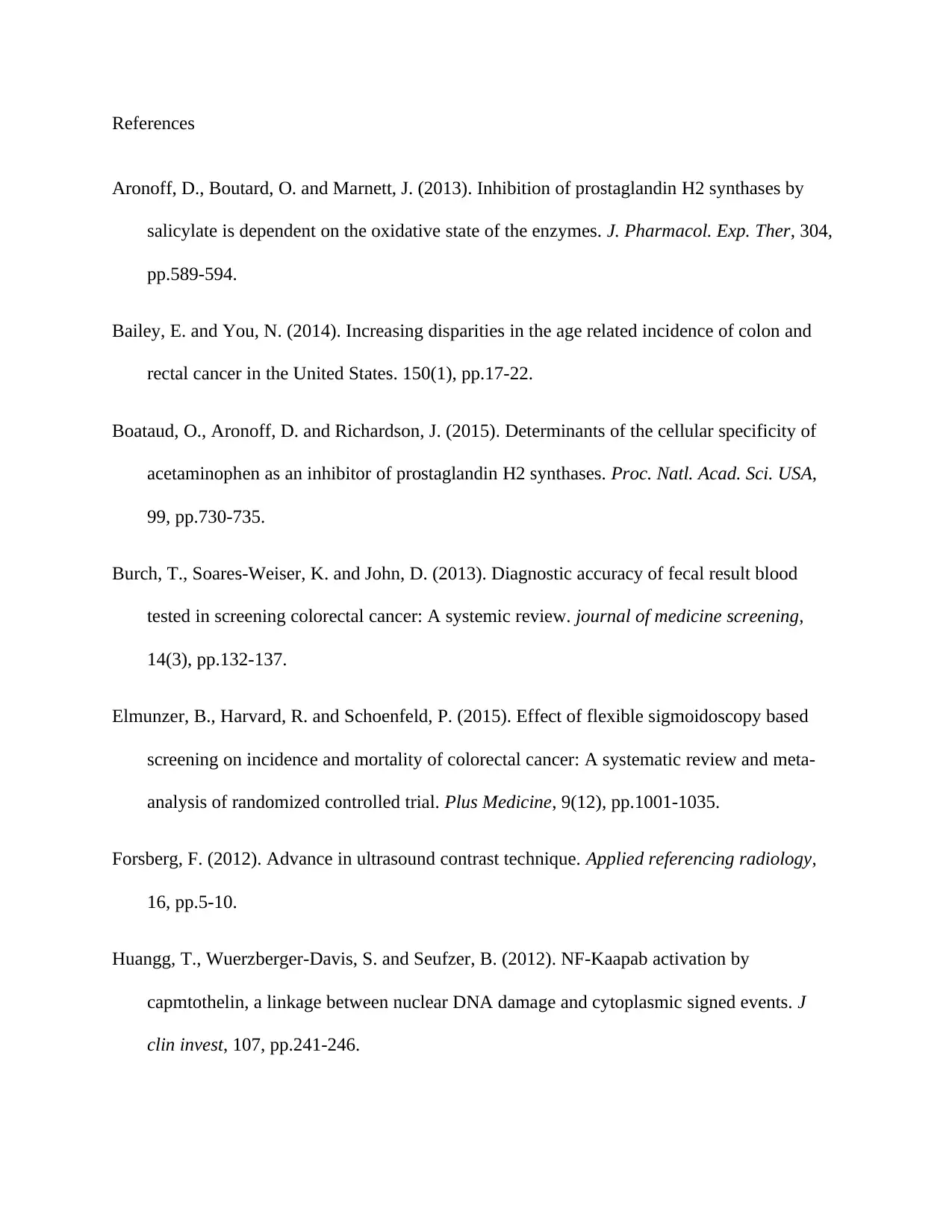HBM 3202 Essay: Colorectal Cancer Therapies, Mechanisms, and Detection
VerifiedAdded on 2023/06/13
|9
|2167
|100
Essay
AI Summary
This essay provides a comprehensive overview of colorectal cancer, focusing on the treatments administered to a patient named Nelly, including 5-Fluorouracil, Irinotecan, and Oxaliplatin, detailing their mechanisms of action. It also explores pain management strategies, such as paracetamol and morphine, and end-of-life care drugs like levomepromazine and clonazepam. Furthermore, the essay outlines various technologies used to detect colorectal cancer, including colonoscopy, DNA testing, stool tests, lower gastrointestinal tract procedures, magnetic resonance imaging, scintigraphy, and abdominal ultrasonography, highlighting their advantages and disadvantages. The essay references various sources to support its discussion on colorectal cancer treatment and detection.

Running header: COLORECTAL CANCER 1
Colorectal cancer
Student’s name
Institutional
Colorectal cancer
Student’s name
Institutional
Paraphrase This Document
Need a fresh take? Get an instant paraphrase of this document with our AI Paraphraser

Colorectal cancer
Colon and rectum tumors are mostly common; the colorectal area is now the third most common
site of cancer cases and deaths globally (Bailey and You, 2014). Cancer of the colon and rectum
develops from the epithelial lining of the intestine. It usually begins as a benign polyp which
later becomes a malignant which penetrates and destroys the normal tissues. The frequency of
occurrence is highest for individuals older than 85 years of age and is higher for individuals who
have had a history of colon cancer in the family. The specific cause of colorectal cancer is still
not known but the risk factors have been identified. The risk factors include breast cancer in
women, high fat and beef intake, and medical record of inflammatory bowel disease and lastly
family history of colon cancer (Ponteri-lewis, 2013). If this disease is detected early and treated,
it could save three people out of four with colon cancer. This essay is going to talk about the
drugs administered to Nelly their mechanism of action and lastly the technologies used to detect
colorectal cancer.
Drugs administered
Colorectal cancer therapy depends on the stage of the disease and it usually done by removal of
the tumor through surgery, adjuvant therapy and supportive therapy. Nellie had a stage IVA
cancer and she was referred to a colonoscopy and it was discovered that nelly had polyps in the
colon which were surgically removed. She later came for adjuvant therapy which included 5-
Fluorouracil, Irinotecan and lastly Oxaliplatin. This kind of therapy was used to reduce the
chances of the cancer coming back after surgery. Pain medication was initiated after targeted
radiotherapy failed to shrink the tumor, the severe back pain was as a result of cancer that had
spread to the spinal cord and was compressing the spinal cord. Pain medication included
paracetamol and morphine. Spinal tumor increased each day which caused more pain and the
Colon and rectum tumors are mostly common; the colorectal area is now the third most common
site of cancer cases and deaths globally (Bailey and You, 2014). Cancer of the colon and rectum
develops from the epithelial lining of the intestine. It usually begins as a benign polyp which
later becomes a malignant which penetrates and destroys the normal tissues. The frequency of
occurrence is highest for individuals older than 85 years of age and is higher for individuals who
have had a history of colon cancer in the family. The specific cause of colorectal cancer is still
not known but the risk factors have been identified. The risk factors include breast cancer in
women, high fat and beef intake, and medical record of inflammatory bowel disease and lastly
family history of colon cancer (Ponteri-lewis, 2013). If this disease is detected early and treated,
it could save three people out of four with colon cancer. This essay is going to talk about the
drugs administered to Nelly their mechanism of action and lastly the technologies used to detect
colorectal cancer.
Drugs administered
Colorectal cancer therapy depends on the stage of the disease and it usually done by removal of
the tumor through surgery, adjuvant therapy and supportive therapy. Nellie had a stage IVA
cancer and she was referred to a colonoscopy and it was discovered that nelly had polyps in the
colon which were surgically removed. She later came for adjuvant therapy which included 5-
Fluorouracil, Irinotecan and lastly Oxaliplatin. This kind of therapy was used to reduce the
chances of the cancer coming back after surgery. Pain medication was initiated after targeted
radiotherapy failed to shrink the tumor, the severe back pain was as a result of cancer that had
spread to the spinal cord and was compressing the spinal cord. Pain medication included
paracetamol and morphine. Spinal tumor increased each day which caused more pain and the

dose of morphine was difficult to titrate due to severe side effects it caused. End of life pathway
drugs were commenced which included levomepromazine and sublingual clonazepam.
Mechanism of action
5- Fluorouracil (5-FU) is an antimetabolite which exerts its action on cells undergoing cycling. It
kills tumor cells which are in the cycling and resting phase of the cell cycle. In the cell
fluorouracil is changed to 5- fluoro-2-deoxyuridine-5-monophosphate (5-FdUMP), which causes
the suppression of thymidylate synthase which later leads to the death of thymineless of cells.
DNA synthesis is inhibited by the penetration of FdUMP. RNA synthesis and function is
inhibited by 5-fluorouradine-5-triphosphate (FUTP) which is a fluorouracil metabolite. In the
tumor cell the mechanism of resistance include an increased thymidylate synthase activity, a
reduced activation of 5-FU, and lastly a decreased drug sensitivity of this enzyme. As a result the
cell is unable to divide and dies.
Irinotecan is a plant derived cell cycle specific (CCS) drugs which is found in the camptothecins
group. It is converted to an active form SN-38 which requires carboxyl esterase (Huangg,
Wuerzberger-Davis and Seufzer, 2012). it inhibits topoisomerase 1 activity hence causing
damage to the DNA. The DNA is damaged by an inhibiting enzyme that cuts and the single
DNA strands during the normal DNA repair process (Maureen, Beidler and cheng, 2013).
Oxaliplatin is a chemotherapeutic agent that contains 1, 2- diaminocyclohexane ligand. Like the
other platinum based compounds it exerts its effect by damaging the DNA and also by inhibition
of RNA synthesis. It induces three types of links which include DNA intra-strand link, DNA
inter-strand crosslinks and DNA-protein crosslinks. Intra-strand links act by the induction of
DNA lesions while the inter-strand link are said to bring about the cytotoxicity of cisplatin. The
drugs were commenced which included levomepromazine and sublingual clonazepam.
Mechanism of action
5- Fluorouracil (5-FU) is an antimetabolite which exerts its action on cells undergoing cycling. It
kills tumor cells which are in the cycling and resting phase of the cell cycle. In the cell
fluorouracil is changed to 5- fluoro-2-deoxyuridine-5-monophosphate (5-FdUMP), which causes
the suppression of thymidylate synthase which later leads to the death of thymineless of cells.
DNA synthesis is inhibited by the penetration of FdUMP. RNA synthesis and function is
inhibited by 5-fluorouradine-5-triphosphate (FUTP) which is a fluorouracil metabolite. In the
tumor cell the mechanism of resistance include an increased thymidylate synthase activity, a
reduced activation of 5-FU, and lastly a decreased drug sensitivity of this enzyme. As a result the
cell is unable to divide and dies.
Irinotecan is a plant derived cell cycle specific (CCS) drugs which is found in the camptothecins
group. It is converted to an active form SN-38 which requires carboxyl esterase (Huangg,
Wuerzberger-Davis and Seufzer, 2012). it inhibits topoisomerase 1 activity hence causing
damage to the DNA. The DNA is damaged by an inhibiting enzyme that cuts and the single
DNA strands during the normal DNA repair process (Maureen, Beidler and cheng, 2013).
Oxaliplatin is a chemotherapeutic agent that contains 1, 2- diaminocyclohexane ligand. Like the
other platinum based compounds it exerts its effect by damaging the DNA and also by inhibition
of RNA synthesis. It induces three types of links which include DNA intra-strand link, DNA
inter-strand crosslinks and DNA-protein crosslinks. Intra-strand links act by the induction of
DNA lesions while the inter-strand link are said to bring about the cytotoxicity of cisplatin. The
⊘ This is a preview!⊘
Do you want full access?
Subscribe today to unlock all pages.

Trusted by 1+ million students worldwide

DNA protein crosslink causes arrest of DNA synthesis and inhibition of messenger RNA
synthesis hence cell death.
Paracetamol also known as acetaminophen is a weak inhibitor of cyclooxygenase-1 (COX-1) and
COX-2 are inhibitors of prostaglandin (Boataud, Aronoff and Richardson, 2015). Prostaglandin
is inhibited if there is a low level of arachidonic acid. Cox-2 is the main isoenzyme when the
arachidonic acid is at low concentration (Aronoff, Boutard and Marnett, 2013). And for this
reason paracetamol selectively prevents prostaglandin synthesis involving Cox-2 this is due to
the lower flux in the pathway that produces decreased level of hydroperoxide.
Opioids acts on the receptors found in neuronal cell membrane to produce effect. The major
three types of receptors include kappa, delta, and mu. Morphine has been found to have a high
affinity for m receptors. G-protein which is a guanine nucleotide protein is coupled to opioid
receptors. The opioid has two sites where it acts upon, the postsynaptic neuron and the
presynaptic nerve terminal. In the presynaptic nerve terminal the action of morphine is to prevent
neurotransmitter release by reducing calcium entry and increasing potassium current. Morphine
also acts on the pain pathways, opioid receptors are present in pain transmission regions of the
nervous system. It acts by inhibition of neurotransmitter release from the primary afferent
terminals found in the spinal cord and also the activation of the midbrain control that is the
descending inhibitors.
Levomepromazine is a neuroleptic agent. It has anti-histamine, anti-emetic and analgesic effect.
It precise mechanism of action is not yet known.
Clonazepam is a benzodiazepam. It is a strong anticonvulsant. Its main type of action is to make
it easier for GABAergic transmission in the brain. This GABA receptors are located in dorsal
synthesis hence cell death.
Paracetamol also known as acetaminophen is a weak inhibitor of cyclooxygenase-1 (COX-1) and
COX-2 are inhibitors of prostaglandin (Boataud, Aronoff and Richardson, 2015). Prostaglandin
is inhibited if there is a low level of arachidonic acid. Cox-2 is the main isoenzyme when the
arachidonic acid is at low concentration (Aronoff, Boutard and Marnett, 2013). And for this
reason paracetamol selectively prevents prostaglandin synthesis involving Cox-2 this is due to
the lower flux in the pathway that produces decreased level of hydroperoxide.
Opioids acts on the receptors found in neuronal cell membrane to produce effect. The major
three types of receptors include kappa, delta, and mu. Morphine has been found to have a high
affinity for m receptors. G-protein which is a guanine nucleotide protein is coupled to opioid
receptors. The opioid has two sites where it acts upon, the postsynaptic neuron and the
presynaptic nerve terminal. In the presynaptic nerve terminal the action of morphine is to prevent
neurotransmitter release by reducing calcium entry and increasing potassium current. Morphine
also acts on the pain pathways, opioid receptors are present in pain transmission regions of the
nervous system. It acts by inhibition of neurotransmitter release from the primary afferent
terminals found in the spinal cord and also the activation of the midbrain control that is the
descending inhibitors.
Levomepromazine is a neuroleptic agent. It has anti-histamine, anti-emetic and analgesic effect.
It precise mechanism of action is not yet known.
Clonazepam is a benzodiazepam. It is a strong anticonvulsant. Its main type of action is to make
it easier for GABAergic transmission in the brain. This GABA receptors are located in dorsal
Paraphrase This Document
Need a fresh take? Get an instant paraphrase of this document with our AI Paraphraser

raphe neurons which acts by inhibiting raphe cell lining. 5-HT synthesis is not inhibited by
clonazepam but it reduces the utilization of 5-HT in the brain.
Technologies used to detect colorectal cancer
Colonoscopy is a procedure in which one views the large intestine using a device known as a
colonoscope (Zapka, Klabunde and Typlin, 2014). It is a thin flexible tube with a camera and a
source of light. This device is inserted in the anus region and through the colon. This device
captures images and videos for the doctor to see. If there is an abnormal growth the doctor will
be able to see. It is also used to remove little amount of tissue for biopsy.
DNA testing has been used to identify individual at risk of colorectal cancer. Through DNA
testing doctors have been able to prevent the disease at an early stage. Clients identified at risk
are genetically cancelled on the disease, so as to understand prevention and treatment measures
(Leissic, 2012).
Stool test has been used to check for the presence of blood. It is the most common method used
for early cancer detection (Burch, Soares-Weiser and John, 2013). The basic examination of the
stool includes checking for color and testing for occult blood. It also checks for the ion
containing portion of the hemoglobin known as the heme which is changed during the movement
in the intestines (Ouyang, Chen and Getzenberg, 2018).
Lower gastrointestinal tract procedure has been used to detect the presence polyps and tumors in
the colon. Barium enema is inserted in the rectum so as to visualize the presence polyps. This
radioscope substance is inserted during fluoroscopy. Other visualizing colon studies include
double contrast studies. In double contrast, it involves the insertion of thick barium solution
clonazepam but it reduces the utilization of 5-HT in the brain.
Technologies used to detect colorectal cancer
Colonoscopy is a procedure in which one views the large intestine using a device known as a
colonoscope (Zapka, Klabunde and Typlin, 2014). It is a thin flexible tube with a camera and a
source of light. This device is inserted in the anus region and through the colon. This device
captures images and videos for the doctor to see. If there is an abnormal growth the doctor will
be able to see. It is also used to remove little amount of tissue for biopsy.
DNA testing has been used to identify individual at risk of colorectal cancer. Through DNA
testing doctors have been able to prevent the disease at an early stage. Clients identified at risk
are genetically cancelled on the disease, so as to understand prevention and treatment measures
(Leissic, 2012).
Stool test has been used to check for the presence of blood. It is the most common method used
for early cancer detection (Burch, Soares-Weiser and John, 2013). The basic examination of the
stool includes checking for color and testing for occult blood. It also checks for the ion
containing portion of the hemoglobin known as the heme which is changed during the movement
in the intestines (Ouyang, Chen and Getzenberg, 2018).
Lower gastrointestinal tract procedure has been used to detect the presence polyps and tumors in
the colon. Barium enema is inserted in the rectum so as to visualize the presence polyps. This
radioscope substance is inserted during fluoroscopy. Other visualizing colon studies include
double contrast studies. In double contrast, it involves the insertion of thick barium solution

followed by pumping of air. This process distinguishes barium coated mucosa and air filled
lumen hence allowing easier detection of little lesions.
Sigmoidoscopy, anoscopy and protoscopy are used to view the lower portion of the colon to
check for rectal bleeding, tumor, polyps or other pathological processes. The anoscope is used to
view the anus and the lower rectum. The sigmoidscopes and protoscopes are rigid scopes used to
view the rectum and sigmoid (Elmunzer, Harvard and Schoenfeld, 2015). The flexible fiberoptic
sigmoidoscope allows the colon to be viewed up to 40-50cm from the anus. During the
procedure biopsy can be performed using a small biting forceps introduced through the
endoscope. If the rectal polyps are viewed that can be removed with a wire snare used to grasp
the pedicle.
Magnetic resonance imaging is used in the checking of polyps in the colon (Forsberg, 2012).
This is a non-invasive technique that uses radio waves and magnetic fields to produce an image
of the area being studied. Oral contrasts agents are used to enhance images. The client lie in the
machine having not eaten or drunk anything for the last 6-8 hours. The entire procedure takes up
to thirty to ninety minutes.
Scintigraphy is a radionuclide testing which uses the radioactive isotopes such as the indium and
iodine. This agents are used to reveal or visualize changes in atomic structures, organ size and
the presence of neoplasm or any other focal lesion.
Abdominal ultrasonography is another method used to check polyps in the colon. This is done by
production of high frequency sound waves in the internal body organs. This echoes are recorded
on an olliscope as they pass through the tissues. This method is used to check the size of and the
configuration of abdominal structures. Advantages of this method is that it needs no ionizing
lumen hence allowing easier detection of little lesions.
Sigmoidoscopy, anoscopy and protoscopy are used to view the lower portion of the colon to
check for rectal bleeding, tumor, polyps or other pathological processes. The anoscope is used to
view the anus and the lower rectum. The sigmoidscopes and protoscopes are rigid scopes used to
view the rectum and sigmoid (Elmunzer, Harvard and Schoenfeld, 2015). The flexible fiberoptic
sigmoidoscope allows the colon to be viewed up to 40-50cm from the anus. During the
procedure biopsy can be performed using a small biting forceps introduced through the
endoscope. If the rectal polyps are viewed that can be removed with a wire snare used to grasp
the pedicle.
Magnetic resonance imaging is used in the checking of polyps in the colon (Forsberg, 2012).
This is a non-invasive technique that uses radio waves and magnetic fields to produce an image
of the area being studied. Oral contrasts agents are used to enhance images. The client lie in the
machine having not eaten or drunk anything for the last 6-8 hours. The entire procedure takes up
to thirty to ninety minutes.
Scintigraphy is a radionuclide testing which uses the radioactive isotopes such as the indium and
iodine. This agents are used to reveal or visualize changes in atomic structures, organ size and
the presence of neoplasm or any other focal lesion.
Abdominal ultrasonography is another method used to check polyps in the colon. This is done by
production of high frequency sound waves in the internal body organs. This echoes are recorded
on an olliscope as they pass through the tissues. This method is used to check the size of and the
configuration of abdominal structures. Advantages of this method is that it needs no ionizing
⊘ This is a preview!⊘
Do you want full access?
Subscribe today to unlock all pages.

Trusted by 1+ million students worldwide

radiation hence they will be no side effects and it also not expensive. The only disadvantage that
it has is that it cannot view structures behind a bone since the bone prevents ultrasonic echoes
from passing to the deeper structures.
it has is that it cannot view structures behind a bone since the bone prevents ultrasonic echoes
from passing to the deeper structures.
Paraphrase This Document
Need a fresh take? Get an instant paraphrase of this document with our AI Paraphraser

References
Aronoff, D., Boutard, O. and Marnett, J. (2013). Inhibition of prostaglandin H2 synthases by
salicylate is dependent on the oxidative state of the enzymes. J. Pharmacol. Exp. Ther, 304,
pp.589-594.
Bailey, E. and You, N. (2014). Increasing disparities in the age related incidence of colon and
rectal cancer in the United States. 150(1), pp.17-22.
Boataud, O., Aronoff, D. and Richardson, J. (2015). Determinants of the cellular specificity of
acetaminophen as an inhibitor of prostaglandin H2 synthases. Proc. Natl. Acad. Sci. USA,
99, pp.730-735.
Burch, T., Soares-Weiser, K. and John, D. (2013). Diagnostic accuracy of fecal result blood
tested in screening colorectal cancer: A systemic review. journal of medicine screening,
14(3), pp.132-137.
Elmunzer, B., Harvard, R. and Schoenfeld, P. (2015). Effect of flexible sigmoidoscopy based
screening on incidence and mortality of colorectal cancer: A systematic review and meta-
analysis of randomized controlled trial. Plus Medicine, 9(12), pp.1001-1035.
Forsberg, F. (2012). Advance in ultrasound contrast technique. Applied referencing radiology,
16, pp.5-10.
Huangg, T., Wuerzberger-Davis, S. and Seufzer, B. (2012). NF-Kaapab activation by
capmtothelin, a linkage between nuclear DNA damage and cytoplasmic signed events. J
clin invest, 107, pp.241-246.
Aronoff, D., Boutard, O. and Marnett, J. (2013). Inhibition of prostaglandin H2 synthases by
salicylate is dependent on the oxidative state of the enzymes. J. Pharmacol. Exp. Ther, 304,
pp.589-594.
Bailey, E. and You, N. (2014). Increasing disparities in the age related incidence of colon and
rectal cancer in the United States. 150(1), pp.17-22.
Boataud, O., Aronoff, D. and Richardson, J. (2015). Determinants of the cellular specificity of
acetaminophen as an inhibitor of prostaglandin H2 synthases. Proc. Natl. Acad. Sci. USA,
99, pp.730-735.
Burch, T., Soares-Weiser, K. and John, D. (2013). Diagnostic accuracy of fecal result blood
tested in screening colorectal cancer: A systemic review. journal of medicine screening,
14(3), pp.132-137.
Elmunzer, B., Harvard, R. and Schoenfeld, P. (2015). Effect of flexible sigmoidoscopy based
screening on incidence and mortality of colorectal cancer: A systematic review and meta-
analysis of randomized controlled trial. Plus Medicine, 9(12), pp.1001-1035.
Forsberg, F. (2012). Advance in ultrasound contrast technique. Applied referencing radiology,
16, pp.5-10.
Huangg, T., Wuerzberger-Davis, S. and Seufzer, B. (2012). NF-Kaapab activation by
capmtothelin, a linkage between nuclear DNA damage and cytoplasmic signed events. J
clin invest, 107, pp.241-246.

Leissic, M. (2012). Advance in genetic testing for care risk. Medsurge nursing, 10(3), pp.123-
125.
Maurren, J., Beidler, R. and cheng, Y. (2013). Campthocesin resistance related to to drug
induced down regulation of topoisomerase 1 and steps occurring after the formation of
protein linked DNA breaks. AnnNy Acad Sci, 803, pp.74-92.
Ouyang, D., Chen, J. and Getzenberg, R. (2018). Non-invasive testing for colorectal cancer: A
review. American journal of gastroentology, 100(6), pp.1393-1403.
Ponteri-lewis, V. (2013). Colorectal cancer. Medsurge nursing, 9(1), pp.9-15.
Zapka, J., Klabunde, C. and Typlin, S. (2014). Screening colonoscopy in the USA: Attitudes and
practises of primary care physians. Journal of general intervid medicine, 27(9), pp.1150-
1158.
125.
Maurren, J., Beidler, R. and cheng, Y. (2013). Campthocesin resistance related to to drug
induced down regulation of topoisomerase 1 and steps occurring after the formation of
protein linked DNA breaks. AnnNy Acad Sci, 803, pp.74-92.
Ouyang, D., Chen, J. and Getzenberg, R. (2018). Non-invasive testing for colorectal cancer: A
review. American journal of gastroentology, 100(6), pp.1393-1403.
Ponteri-lewis, V. (2013). Colorectal cancer. Medsurge nursing, 9(1), pp.9-15.
Zapka, J., Klabunde, C. and Typlin, S. (2014). Screening colonoscopy in the USA: Attitudes and
practises of primary care physians. Journal of general intervid medicine, 27(9), pp.1150-
1158.
⊘ This is a preview!⊘
Do you want full access?
Subscribe today to unlock all pages.

Trusted by 1+ million students worldwide
1 out of 9
Your All-in-One AI-Powered Toolkit for Academic Success.
+13062052269
info@desklib.com
Available 24*7 on WhatsApp / Email
![[object Object]](/_next/static/media/star-bottom.7253800d.svg)
Unlock your academic potential
Copyright © 2020–2025 A2Z Services. All Rights Reserved. Developed and managed by ZUCOL.